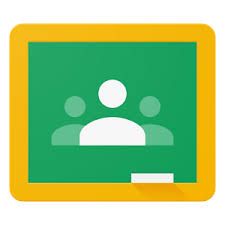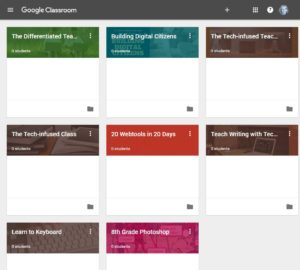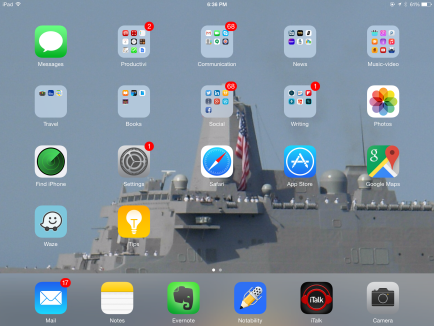 A few weeks ago, I got an email from Nancy with a great suggestion for an article topic: Google Classroom. She writes from her perspective as a Kansas City teacher who loves teaching and blogging. I think you’ll enjoy her ideas on essential apps for her Google Classroom:
A few weeks ago, I got an email from Nancy with a great suggestion for an article topic: Google Classroom. She writes from her perspective as a Kansas City teacher who loves teaching and blogging. I think you’ll enjoy her ideas on essential apps for her Google Classroom:
Not much time has passed since Google Classroom first entered K-12 and higher ed classes, outmaneuvering all other classroom software providers with its availability and a great variety of apps.
A well-known fact: A large portion of every teacher’s workflow is actually consumed by the assignment review, collecting the student work, notifying the class about upcoming events, changes in the timetable, revision, and grading.
In Google Classroom many educators like me found a great additional functionality and apps, which allowed managing the workflow efficiently, leaving more time for the teaching.
In our school we started using Google Classroom LMS as a way to collect, review and grade the assignment, now we use it as a basis for creating greater learning opportunities becoming real due to the apps that hugely extend the functional set and diversify the learning.
Questioning the students
Because Google Classroom doesn’t have the functionality for building interactive quizzes I started searching for the app that would make the answering process engaging for my students, that’s when I stumbled upon Quizlet. Sure thing, simple questioning can still be performed in the Google forms, but Quizlet is what helped me to make the whole process engaging and interactive at once. Here the learners use the study cards, play educational games, and take tests that will be graded automatically.
At recess, I usually input the new vocabulary words in Quizlet, with cards and audio files so that students could access them later while doing the homework.
Checking the written assignments
Before we adopted Google Classroom, I used to check all of the essays in my class via Google Search, copying and pasting the written fragments of text into the browser if I had doubts. This kind of quality control of the written assignments appeared to be kind of random and ineffective. Even if I didn’t find the matches on the web, it didn’t certainly guarantee the student wasn’t just recycling brother’s or sister’s essay from the previous year.
For now, there’s only a one similarity checker available for Google Classroom, and, luckily for me, it solves all problems I mentioned. Unicheck helps to scan the assignments across the internet, open access repositories and private databases, generating the report automatically and landing them on my email. Lately, I discovered they also have a plagiarism checker Google Docs add-on that is very convenient for students as they can pre-check their writing independently.
In general, in Google Classroom you can create announcements, ask something, and get a reply. Using such features, our class formed a thread dedicated to the particular topic, let it be the extra important reminder, a permission form for the trip or the documentary we saw in the class.
It was a good option. Still, reminders serve the purpose in a very limited way. GoGuardian chat helps to communicate important announcements personally so that no one in the class gets interrupted. I send announcements to the particular student or the entire class when needed, for this, the particular class should be in the active mode. Thus, when we have Biology class I’m able to see, read and message the students in the Biology class; with my Cytology students, I’m interacting only when I set the Cytology class as active. No more mess in the classroom.
Making the grading transparent
Grading assignments in Google Classroom is not always an easy thing. Sooner or later you face situations when you have to explain to someone their grade in details, point out the gaps in the knowledge, and light the way to the personal improvement. Now I can’t find the better way to do this than using personalizing grading rubrics in ForAllRubrics. I create the class and put there the names of the students, select the pre-made rubric format or create my own. For example, the essay’s main part should include an argument and at least 2-3 supportive points, if I can trace those in the text the student gets more grading points for each with an understanding that hides behind the final grade.
ForAllRubrics is very convenient as after grading I can get daily class reports and weekly progress reports. The data considering my class’s progress is measurable; basing on it, I can judge where we are going and where we are at the moment regarding the whole program.
Taking virtual trips together

Learning complex concepts in classes can be a struggle. While some students perfectly absorb textual information, the others need real examples to fully imagine how things work. In NearPod, teachers can find the variety of interactive lessons already recorded to apply them in your class, including the virtual field trips. While the lesson is presented on the main screen, the students can also see the presentation on their own devices, asking the questions or giving the responses to the answers.
Being connected to their own devices students don’t have to worry about skipping valuable information. They can always get back to the point missed and catch up.
As well, in NearPod, students can go through the interactive quizzes and polls, actively participating in the classroom’s workflow.
To sum it up
What I found the most compelling about Google Classroom, is that the teacher actually makes an emphasis on growing the problem-solving and teamwork skills of the students rather than focusing on secondary things such as revision and lesson planning routines. If you’re already using Google Classroom, just find the right applications that will help you challenge, engage, and teach your students more effectively.
— Nancy is an enthusiastic teacher, author, editor and blogger based in Kansas City. She earned a Bachelor of Science Degree in Biology at St. Petersburg College and has been educating high schoolers for over seven years. Technology has always been her second lifelong passion. After getting her master’s degree in Technology and Learning at Western Governors University, she participated in “The Impact of Digital Technology on Learning” research. That’s when she first realized that every teacher can transform the daily classroom routine into engaging and exciting experience. By this time, she had accumulated many stories, personal teaching tips, and daily workflow lifehacks that she shares through blogging. You can find her articles on ed tech educational sources like teach.com, teacherswithapps.com, students.org, and collegelifestyles.org.
Jacqui Murray has been teaching K-18 technology for 30 years. She is the editor/author of over a hundred tech ed resources including a K-12 technology curriculum, K-8 keyboard curriculum, K-8 Digital Citizenship curriculum. She is an adjunct professor in tech ed, Master Teacher, webmaster for four blogs, an Amazon Vine Voice, CSTA presentation reviewer, freelance journalist on tech ed topics, contributor to NEA Today, and author of the tech thrillers, To Hunt a Sub and Twenty-four Days. You can find her resources at Structured Learning.




































1 thought on “Learn Smarter, Not Harder: 5 Essential Google Classroom Apps”
Comments are closed.